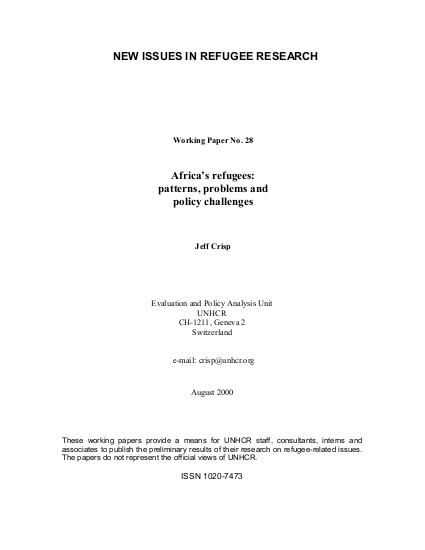
Individuals and organizations who work on behalf of refugees are frequently affected by a syndrome which can best be described as “humanitarian pessimism”.1 According to this perception, the state of the world – and Africa in particular - is in perpetual decline, with life becoming progressively more nasty, brutish and short for ever larger numbers of people. Each war that breaks out is more violent than the last, and every population displacement that occurs is described as being “unprecedented” in its scale, speed and degree of human tragedy. While humanitarian pessimists are all too frequently unconstrained by a knowledge of history or a respect for empirical data, recent events in countries such as Angola, the Democratic Republic of the Congo (DRC), Rwanda and Sierra Leone, not to mention Ethiopia and Eritrea, have lent some credibility to their case. Some depressing conclusions can also be drawn from the statistical data collected by organizations such as the Office of the UN High Commissioner for Refugees (UNHCR) and the US Committee for Refugees (USCR). For they show that that the problem of human displacement in Africa is large - and possibly growing - in scale, that it is geographically widespread, and that it has become (if it was not so before) highly complex in nature.2 Moreover, there is a great deal of qualitative evidence to suggest that the situation of Africa’s displaced people is becoming increasingly precarious, and that even those who succeed in escaping from their own country are unable to find a safe refuge in other states. The first part of this article examines the changing scope, scale and dynamics of the refugee problem in Africa, drawing extensively on the statistical data referred to in the preceding paragraph. The article then goes on to analyze three specific policy challenges related to the rights and welfare of the continent’s displaced people: the need to preserve the principle and practice of asylum; the need to reinforce security and the rule of law in refugee-populated areas; and the need to facilitate the safe return and sustainable reintegration of people who have been forced to flee from their own country or community. This article employs the generic term “displaced people” to refer to those who have left their usual place of residence in order to escape from persecution, armed conflict or violence. People who move in such circumstances and who cross an international border are referred to as “refugees”, while those who remain within their country of origin are described as “internally displaced persons” (IDPs). Refugees and internally displaced persons who have gone back to their own country or community are described “returnees”. The article does not examine the situation of those people who are commonly described as “disaster-induced migrants”, “development-induced migrants” or “ecological refugees”.